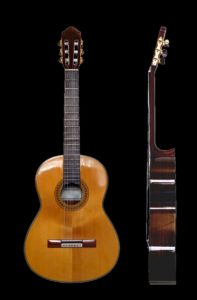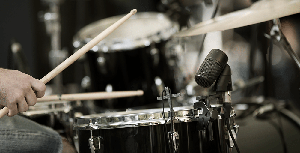One of the first questions I get from people who are looking to pick up the guitar is, “what is the difference between a classical, acoustic, and electric guitar? And which one should I choose for my first guitar?”
It really all comes down to what you would like to accomplish with the instrument and your personal
preference for genre of music, sound, feel of the instrument, and of course, price. No arbitrary rule states that, for example, all beginners must begin on the classical guitar.
By explaining the main differences among these three types of guitars, this article hopes to help you choose a guitar.
Strings
The most obvious difference among these three types of guitars are their strings. Classical guitars use nylon strings, while acoustic and electric guitars use steel strings.
Nylon strings tend to sound a lot warmer and fuller compared to steel strings. They are also softer and gentler on the fingertips, so some beginners may decide to start with a classical guitar.
Nylon string guitars can be heard in Latin, Flamenco, Spanish, and Classical styles of music. It is quite uncommon to hear classical guitars in more contemporary genres like Pop and Rock.
Steel strings are rougher on your fingertips, compared to nylon strings, for the first month or so before you start growing calluses and your fingertips are used to the constant rubbing and pressure against steel strings.
Steel string acoustic guitars tend to sound brighter with a sharper “attack” to the sound. They are also able to sustain a note longer than nylon strings can.
For electric guitars, which also use steel strings, the strings tend to have a smaller impact on the overall sound of the instrument, because the sound of an electric guitar can be affected by other factors such as the type of amp, amp settings, guitar pedals, settings of the knobs and switches on the guitar, etc.
Sound Production
Classical and acoustic guitars produce and amplify sound in the same way. The vibration of the strings causes the hollow body of the guitar to resonate and project that specific frequency of sound.
On the other hand, electric guitars are fitted with magnetic pickups that sit under the steel strings. When the strings vibrate, the pickups convert that magnetic energy into an electrical signal, which is then routed out of the guitar into an amp via a cable. Without an amp, you won’t be able to hear your electric guitar.
Genres
Acoustic guitars are used in many contemporary forms of music and even some not-so-contemporary forms like the Blues. You will definitely hear acoustic guitars more often than classical guitars in your favorite recordings.
A single model of electric guitar can be made to fit several different genres. For example, the Fender Telecaster is used in genres like Jazz, Blues, Soul, Funk, Pop, Rock, Country, and even Metal. An electric guitar is more versatile than classical and acoustic guitars. There is a caveat though; I have yet to find a pedal or setting that allows my electric guitar to convincingly sound like an acoustic or classical guitar.
Shape and size
Guitars come in many shapes and sizes. The rule of thumb for classical and acoustic guitars is, the bigger the size, the louder and fuller-sounding it will be.
Classical guitars tend to come in a single “default” shape.

Acoustic guitars, on the other hand, have a variety of shapes such as Concert, Grand Concert, Auditorium, Grand Auditorium, Dreadnought, Jumbo, Travel, etc.

Electric guitars have the widest range of shapes. Since the size and shape of the body of the electric guitar tend not to influence the sound of the instrument as much as classical and acoustic guitars, manufacturers are free to play around with different designs.

A Doraemon shaped electric guitar is one of the more interesting shapes I’ve come across in my lifetime.
Feel and Suitability
Besides the strings, a few other factors affect the feel and suitability of an instrument. This aspect is difficult to grasp until you try out some of these guitars yourself, but I’ll do my best to describe the differences.
The first big difference between the three guitars is the fretboard width. Classical guitars have the widest fretboard width, which will make using your thumb to fret notes (a popular technique used by John Mayer and Jimi Hendrix) difficult to impossible depending on the size of your hands. This extra width is to facilitate the extra thickness of the nylon strings. Acoustic and electric guitars have similar fretboard sizes, but they can vary from manufacturer to manufacturer. For example, an acoustic guitar made by Taylor guitars usually have a wider fretboard than one made by Martin; a modern-day Fender Telecaster has a wider fretboard width than a vintage Fender Telecaster. Regardless of the varying widths, acoustic and electric guitars have slimmer fretboard widths than classical guitars.
The next big difference is weight. Acoustic and classical guitars are a lot lighter than electric guitars, and acoustic guitars are slightly heavier than classical guitars. Electric guitars are heavier because their bodies are usually one solid piece of wood, compared to a hollow acoustic or classical guitar. An electric guitar also has more metal components, such as the bridge, saddles, pickups, volume and tone potentiometers, etc. In comparison, acoustic and classical guitars are more transportable.
The final difference comes in the ease to adjust the instrument. By far the easiest to play would be an electric guitar, as the string action (distance between strings and fretboard) can be brought down much lower than an acoustic or classical guitar without losing the tone. Acoustic and classical guitars lose quite a bit of volume and tone when the strings are brought nearer to the fretboard, so, when adjusting string action for playability, try to strike a balance between “more tone/volume” and “easier to play.”
Adjusting the string action on an electric guitar is also a lot easier. Anyone can learn it and start making customised adjustments within a day. Acoustic and classical guitars on the other hand require special tools and steady hands to make adjustments; therefore, more often than not, the person making adjustments will be a professional tech instead of yourself.
… And of course, price.
Perhaps the most important difference among the three types of guitars is the price. Without a doubt, an electric guitar (the most versatile of the three) is going to cost the most. Compared to an acoustic and classical guitar, an electric guitar has more electrical and metal components. Not to mention, in order to hear what you’re playing on an electric guitar, you need an amp, which is another cost on its own. Acoustic and classical guitars on the other hand cost around the same price.
So how much more expensive are electric guitars? Well, not much if you’re only considering guitars at the lowest end. The cheapest electric guitars on Sweetwater.com cost between $119 to $129 USD. Acoustic and classical guitars are between $109 to $119 USD. But once you factor in the cost of an amp, the combination of electric guitar and amp can easily be hundreds of dollars more than an acoustic or classical guitar on its own.
I personally would not recommend buying the cheapest guitar you can find, even if it’s your first one, because cheap guitars tend to have spotty workmanship, and they don’t retain much resale value compared to mid to high end models. That being said, the choice is completely up to you.
Try before you buy
Although you can get a pretty good idea of the differences between the three types of guitars, it’s always best to try them out to physically experience the differences. Everyone is built slightly differently; some people have small hands with stubby fingers while others have big hands with long fingers. What you prefer is likely drastically different from what I prefer.
Already made a decision?
Once you’ve made a decision, it’s a good idea to get it professionally set up. Nothing makes a guitar play better than having a professional set up the action and intonation perfectly. A cheap guitar set up well is going to play a lot better than an expensive guitar that has a terrible setup (the cheap guitar won’t sound better though).
I’d also like to welcome you aboard a lifelong journey of playing music. There are many ups and downs along the way, but stick with it and you will begin to notice many subtle and positive changes in your mindset and physical coordination.
The next step is to learn some songs and techniques to get you up and running, so be sure to check out Liberty Park Music for tons of high quality structured music lessons!
Ready to learn the guitar?
Start learning with our 30-day free trial! Try our guitar courses!
About Liberty Park Music
LPM is an online music school. We teach a variety of instruments and styles, including classical and jazz guitar, piano, drums, and music theory. We offer high-quality music lessons designed by accredited teachers from around the world. Our growing database of over 350 lessons come with many features—self-assessments, live chats, quizzes etc. Learn music with LPM, anytime, anywhere!











I really need this kind of information and must share with my circle. Thanks for sharing with us.